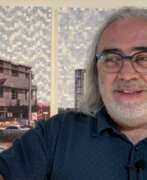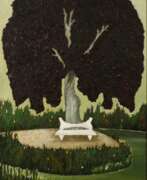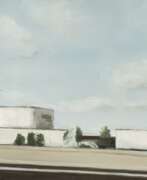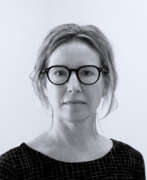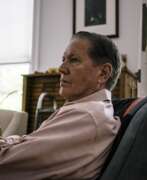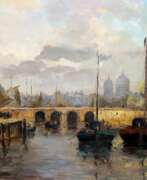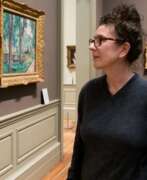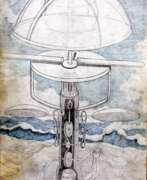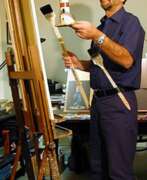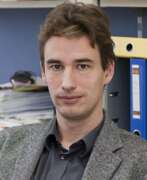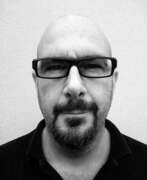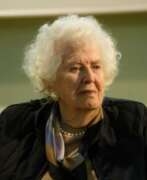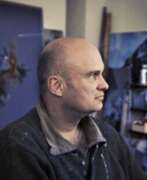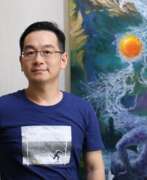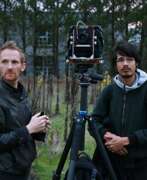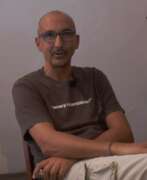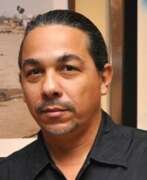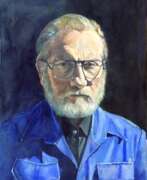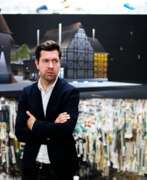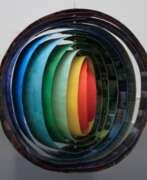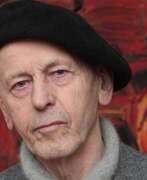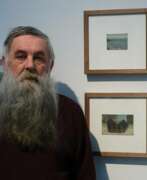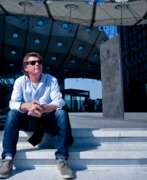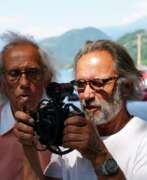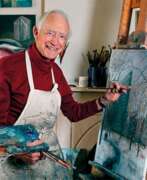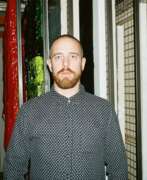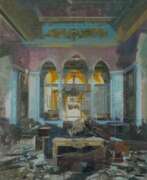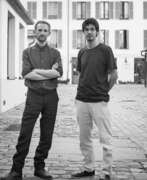Architectural landscape Contemporary art
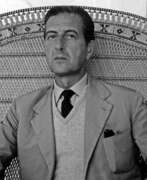

Fabrizio Clerici was an Italian painter, draftsman, illustrator, scenographer and architect.
Clerici earned a degree in architecture and was greatly influenced by antiquities, Renaissance and Baroque painting and architecture. In 1943, Clerici held his first solo exhibition at the Galleria dell'Arte Cairola in Milan, featuring drawings, watercolors, lithographs and etchings. His first book illustrations belong to the same period.
In 1947, Clerici began a prolific career in theater, ballet and opera with his debut as a stage designer in a production of George Bernard Shaw's play Mrs. Warren's Profession. The following year he participated for the first time in the Venice Biennale. There he met Salvador Dalí and created the sets and costumes for Igor Stravinsky's Orpheus, which was performed at the La Fenice Theater. In 1949 he created large-scale architectural fantasy paintings.
The further life of the multifaceted artist Fabrizio Clerici was full of work in a variety of fields of art, creative successes and exhibitions. His work has been exhibited in many museums in the United States, including MoMA and the Guggenheim Museum, as well as in France, such as the Pompidou Center.
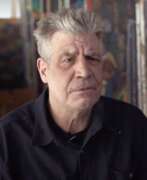

Chuck Connelly is an American painter.
Connelly graduated from the Tyler School of Art in Elkins Park, Pennsylvania in 1977. Afterward, he moved from the Philadelphia area to New York City, where Robert C. Atkins became one of his first patrons.
Connelly went on to spend two years in Germany, where he continued to develop his art work with the patronage of Atkins. Upon his return to New York in the early 1980s, the Annina Nosei Gallery began to show his work. During this time, Connelly began to rise to fame along with Julian Schnabel and Jean-Michel Basquiat in the New York City art world.


Tom Fabritius is a German painter and graphic artist living and working in Leipzig, a representative of the so-called New Leipzig School.
Tom studied painting and drawing at the Academy of Visual Arts in Leipzig. In 2002 he co-founded the production gallery LIGA in Berlin-Mitte. Tom Fabritius paints in a wide variety of genres as he finds his motifs in the stream of images in the television. He switches between programs and quickly and intuitively captures individual moments of an image with his camera. From this collection, he selects individual images, which he then paints with watercolors.
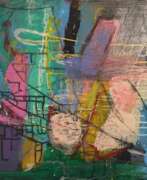

Victor Isaakovich Gershman (Russian: Виктор Исаакович Гершман) was a Soviet and Russian artist of the twentieth and twenty-first centuries. He is known as a painter and nonconformist graphic artist.
Victor Gershman began his artistic career early - already at the age of 14 his drawings were exhibited at the International Exhibition of Children's Drawings. He participated in the Second World War, after demobilization and graduation from the Institute he worked at textile mills, but also devoted time to creativity. He traveled a lot, painting landscapes, architecture, still lifes. The artist mastered various techniques - watercolor, ink, pencil, oil, collage. In the 1960s and 1970s he became interested in non-traditional and abstract painting.
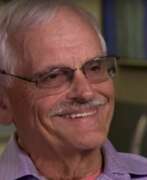

Richard John Haas is an American muralist.
In the mid-sixties Haas began creating small dioramas depicting interiors, and then with views of the streets of New York. He later became involved in the large-scale transformation of the city's exterior and interior environments.
Richard John Haas is known for his architectural murals in the trickster style (trompe-l'œil). He also utilizes almost every available technique in the opportunity to enhance and transform urban spaces. Both interior and exterior murals created by the artist on buildings are always based on historical events. During his artistic career, Haas has created many large-scale murals on public buildings in many U.S. cities. And his prints faithfully reproduce magnificent American facades and streetscapes.
Haas's work has been recognized with many awards, including the Medal of Honor from the American Institute of Architects; he became a Fellow of the National Academy of Design in 1994 and served as president of the Academy from 2009 to 2011.
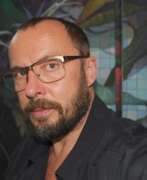

Jens Hausmann, a German painter, is renowned for his distinctive approach to painting, where architecture plays a central role, yet it's not the essence of his work. His paintings explore the nuanced relationship between architectural forms and the natural world, often depicting buildings and landscapes intertwined in a complex dance of culture and nature. Hausmann's work is characterized by a constructivist approach, where the real and the constructed realities blend seamlessly, creating scenarios that challenge the viewer's perception of space and environment.
Jens Hausmann's art is deeply influenced by modernism, yet it critiques its principles by showcasing buildings in emotionally arctic modernism being slowly reclaimed by nature. This juxtaposition reflects a critical view of modernist ideologies, suggesting a reevaluation of our relationship with the built environment and the natural world. His paintings don't just depict scenes; they invite viewers into a contemplative space where the boundaries between the interior and exterior blur, prompting reflections on the human condition and our impact on the planet.
His works are a testament to the complex interplay between humanity and nature, where even the most remote natural landscapes bear the marks of human activity. The artificiality of the colors in his landscapes and the absence of human figures underscore the theme of nature being "culturally contaminated" in the Anthropocene era. Jens Hausmann's paintings are not only visually striking but also intellectually stimulating, inviting viewers to ponder the deeper meanings and implications of his depicted scenarios.
For collectors and experts in art and antiques, Jens Hausmann's work offers a unique blend of architectural precision and philosophical depth, making his paintings highly sought after in both European and Brazilian art scenes. His ability to weave together elements of architecture, nature, and human influence creates a visually and conceptually rich tapestry that speaks to a wide audience.
To stay informed about Jens Hausmann's latest works and exhibitions, signing up for updates is highly recommended. This subscription will ensure that you are among the first to know about new sales and auction events related to his work, providing exclusive insights into the evolving world of contemporary art.
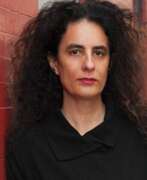

Susan Hefuna is a German-Egyptian artist working in various fields of art.
She was born from the union of an Egyptian and a German, which put her at the intersection of the two cultures in which she was immersed. Hefuna completed her PhD in multimedia at the Institute for New Media in Frankfurt. She lives between Egypt and Germany and works in a variety of media including drawing, photography, sculpture, installation, video and performance. Hefuna combines her Egyptian and German roots in her work, using urban imagery, typography and traditions from both to build a bridge between the two cultures.
Hefuna's work often incorporates the form or image of the characteristic mashrabiya, an oriental carved wooden or stone architectural lattice screen.
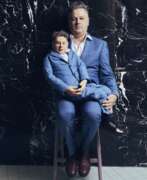

Christian Heuchel is a German artist, architect, urban planner and professor.
He studied architecture in Karlsruhe and architecture at the Düsseldorf Academy of Art, where he has taught since 2000. Heuchel has been with the O&O Baukunst office since 2000, took over the Cologne office in 2006 and has been a partner of O&O Baukunst Berlin/Cologne/Vienna since 2011.
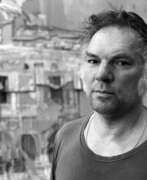

Valerii Nikolaevich Koshliakov (Russian: Валерий Николаевич Кошляков) is a Russian painter, graphic artist, author of installations, lives and works in Germany, France and Moscow.
He studied at the Rostov Grekov Art School. Koshliakov works mainly with images of architecture, which in his works appears as a memory of the former greatness. The artist uses canvas, paper, kraft, but most often cardboard, pieces of which make up huge canvases and entire installations. On this basis with diluted colors he creates a very light, yet monumental painting, which imbues the material with a web of sweat, reflecting the author's unique vision.
The works of this successful artist are in the collections of the world's major museums, including the Tretyakov Gallery, the Guggenheim Museums in New York and Bilbao.
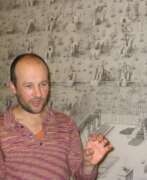

Paul Noble is a British artist, draughtsman and sculptor living and working in London.
Paul Noble studied at Sunderland Polytechnic and Humberside College of Higher Education in Hull. He was one of the five founding members of City Racing, an influential community of artists in London in the 1990s.
Although his practice encompasses drawing, sculpture and animation, Paul Noble is known primarily as a meticulous draftsman creating complex schemes. His compositions, based on fictional urban architecture, reflect disorder, circuit logic and self-portraiture at the same time. His best known conceptual project, Nobson Newtown, was first shown in a solo exhibition at Chisenhale Gallery in 1998. This series of large-scale drawings depicts a fictional city run by architect Paul, Noble's alter ego.
In addition to pencil drawings, the artist works in a combined drypoint and aquatint technique. He starts drawing from the upper left corner, gradually filling the entire space, and some large-scale drawings reach a size of 7 x 6 meters.
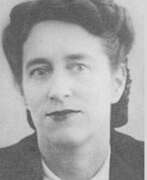

Edith Rimmington was a famous English surrealist painter, poet and photographer. From the beginning to the end of her career, Rimmington was deeply influenced by Salvador Dali. She had an inquisitive mind and boundless imagination and thus became a highly respected and central member of the British Surrealist group. Rimmington also worked with color photographs of coastal landscapes.


Emilio Sánchez Font was a Cuban-born American painter and graphic artist known for his architectural paintings and graphic lithographs. His works are in the permanent collections of renowned museums such as: The Metropolitan and the Museum of Modern Art in New York, the National Gallery of Art in Washington and many others.
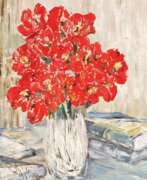

Bronisława Wilimowska is a Polish artist.
She studied painting in Paris at the Ecole des Beaux-Arts. Her works include subjects related to the war and post-war reconstruction of Poland, as well as landscapes from her many trips abroad. After the war, Wilimowska worked for the country's Ministry of Culture and Art and received many state awards.


Stepan Petrovich Yaremich (Russian: Степан Петрович Яремич) was a multifaceted Ukrainian artist and art historian, whose career spanned the late 19th and early 20th centuries. His profound contributions to art history and preservation, particularly during the tumultuous post-revolutionary period in Russia, underscore his significance beyond his work as a painter. Yaremich's expertise in Western European drawing, bolstered by his years in Paris where he amassed an impressive collection featuring masters like Watteau and Fragonard, highlighted his remarkable connoisseurship.
Educated in Kiev and Paris, Yaremich was associated with the "World of Art" movement and worked closely with figures like Alexandre Benois. He was not just an artist but a respected art expert, often involved in the restoration and cataloging of Russian and Western European art. His time at the Hermitage and Russian Museum showcased his dedication to art preservation, contributing significantly to the fields of art history and conservation.
Yaremich's artistic legacy includes landscapes of St. Petersburg, Venice, and other locales, characterized by a unique approach to color and form that distinguished his work from his contemporaries. Despite the critical acclaim, it was his behind-the-scenes work as an art historian and conservator that solidified his enduring impact on the art world.
Collectors and experts in art and antiques will find Yaremich's work both compelling and significant, underlining the importance of not only creating art but also preserving it for future generations. For updates related to Stepan Petrovich Yaremich, including sales and auction events, sign up for our newsletter. This subscription will keep you informed about the latest findings and opportunities to acquire works associated with this remarkable figure in art history.
